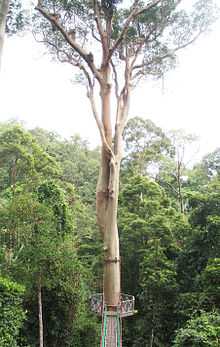Koompassia excelsa
| Koompassia excelsa | |
|---|---|
 | |
| Koompassia excelsa | |
| Conservation status | |
| Scientific classification | |
| Kingdom: | Plantae |
| (unranked): | Angiosperms |
| (unranked): | Eudicots |
| (unranked): | Rosids |
| Order: | Fabales |
| Family: | Fabaceae |
| Genus: | Koompassia |
| Species: | K. excelsa |
| Binomial name | |
| Koompassia excelsa (Becc.) Taub.[2] | |
Koompassia excelsa, also known as Tualang (Tapang), or Mengaris, is an emergent tropical rainforest tree species in the Fabaceae family. It is found in Indonesia, Malaysia, the Philippines, and Thailand. It is one of the tallest tropical tree species: the tallest measured specimen is 85.8 m[3] or 88 m[2](281 or 289 ft) tall.
Tualangs grow mostly in lowland rainforests where they tower over the canopy. Like most tall rainforest trees it has huge buttress roots to support its weight. This is because the majority of the nutrients in rainforest soil are very near the surface, making large spreading roots more effective than deep ones.[4]
Tualangs grow branches above the canopy (around 30 m or 100 ft) and have slippery trunks, which makes them attractive to giant honey bees Apis dorsata who hang their huge combs from the branches. The bees protect the trees from loggers, as the value of the honey is higher than that of the timber.[5] There is also a taboo against felling the tree in parts of Sarawak, and only naturally felled trees (due to storms) are used for timber.[6]
References
- ↑ Asian Regional Workshop (Conservation & Sustainable Management of Trees, Viet Nam) 1998. Koompassia excelsa. 2006 IUCN Red List of Threatened Species. Downloaded on 19 July 2007.
- ↑ 2.0 2.1 Hou, Ding (2000). "Koompassia excelsa (Becc.) Taub.". In Soepadmo, E.; Saw, L. G. Tree Flora of Sabah and Sarawak. (free online from the publisher, lesser resolution scan PDF versions) 3. Forest Research Institute Malaysia. pp. 153–154. ISBN 983-2181-06-2. Retrieved 12 June 2008.
- ↑ "Borneo". Eastern Native Tree Society. Retrieved 12 June 2008.
- ↑ Blue Planet Biomes
- ↑ "Peninsular Malaysian rain forests". Terrestrial Ecoregions. World Wildlife Fund.
- ↑ http://www.sarawakforestry.com/htm/snp-np-loagan.asp
